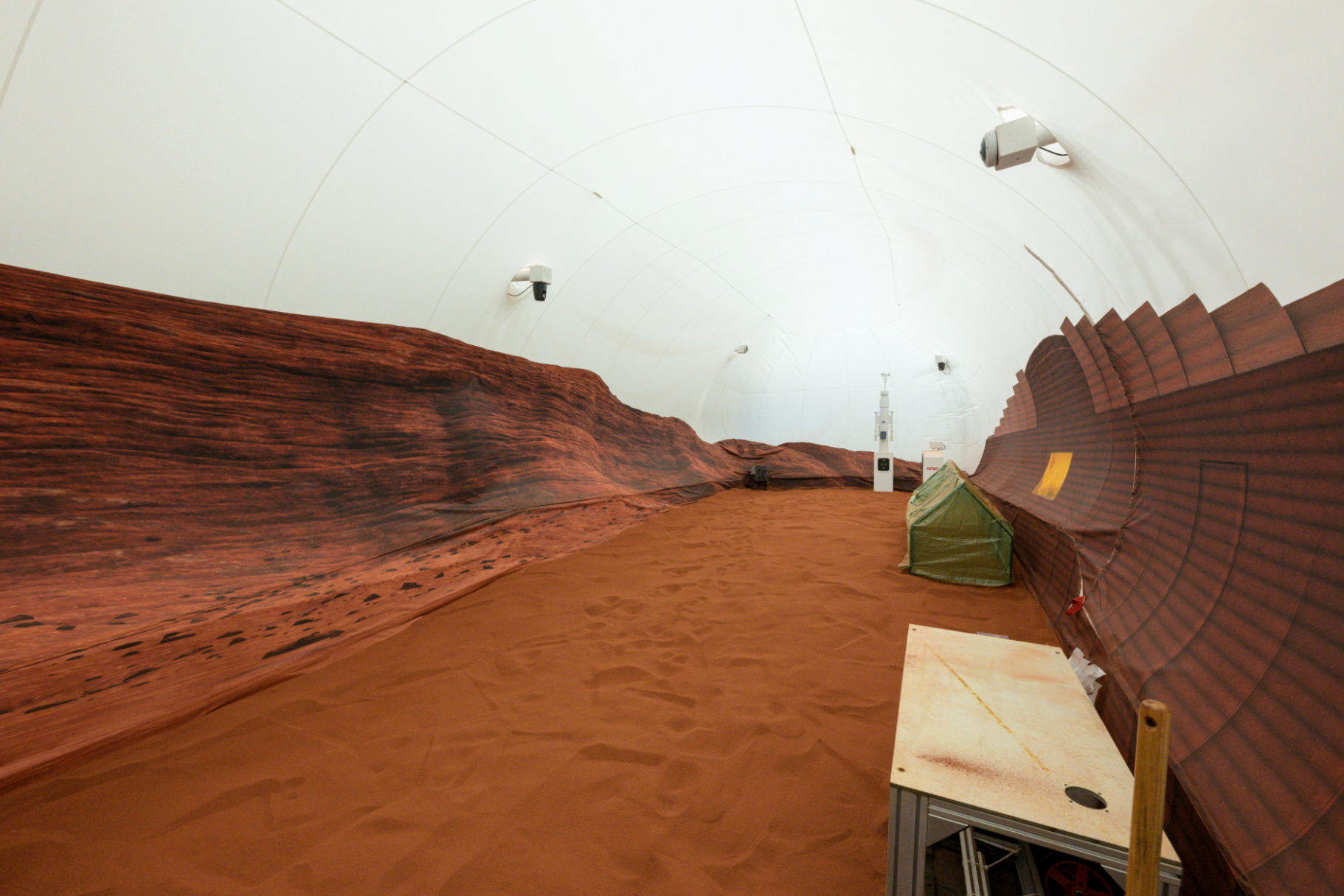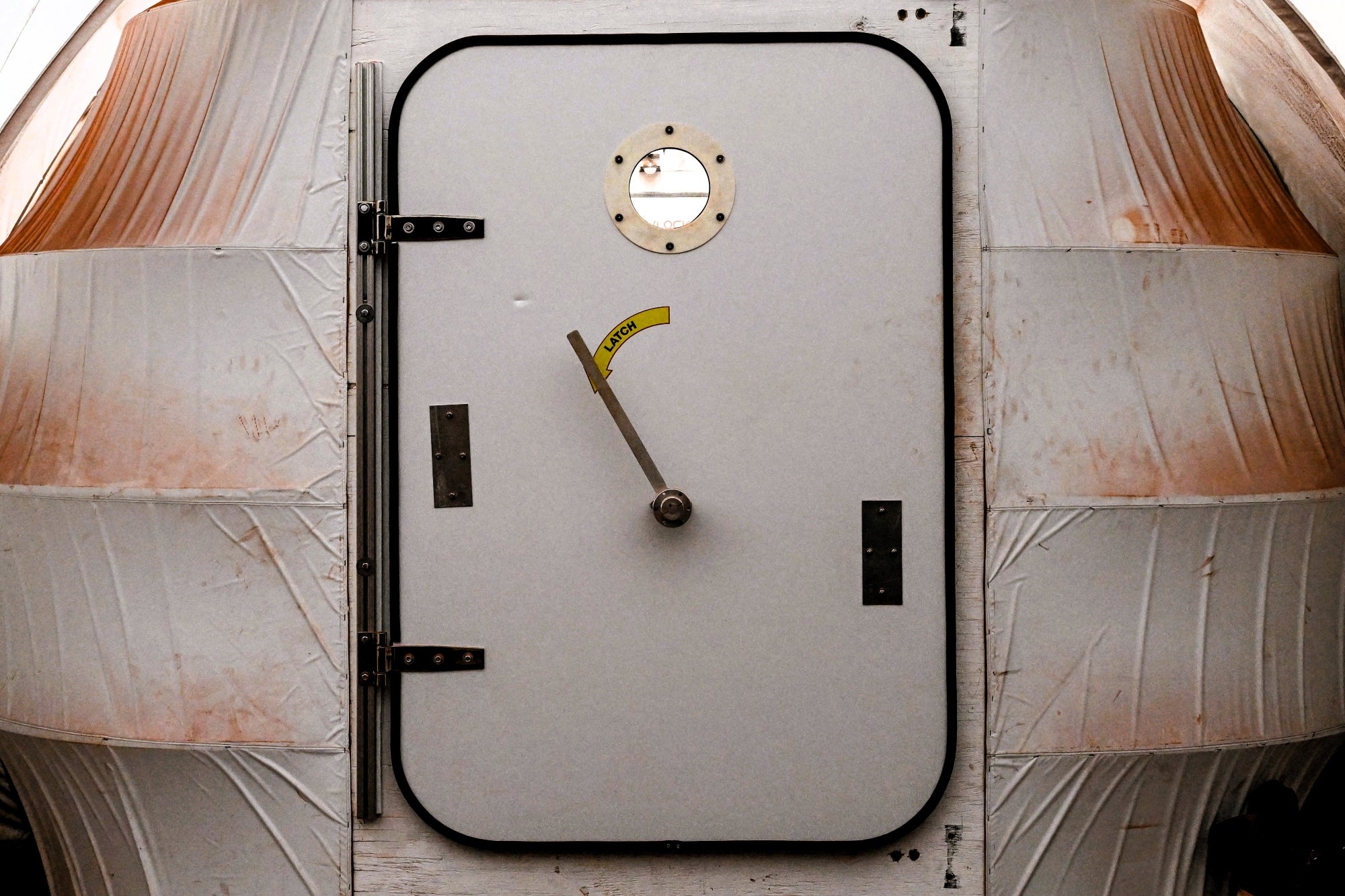

SCIENCE
“Wild Discoveries from Isolation Studies: What Drunken Fights and Shocking Experiences Reveal About Life on Mars”
Published
1 month agoon
By
OBS
On New Year’s Eve 1999, two drunk Russians had a fistfight that quickly became an international incident. The altercation took place inside a small spaceship simulator on the outskirts of Moscow, which the two men had been stuck inside for nearly a month as part of a 110-day isolation experiment for future Mars missions.
The 10-minute-long brawl was so intense that it left blood splatters on the walls, which one of the international members of the mission photographed to send to her colleagues. Judith Lapierre, a 32-year-old Canadian scientist who was one of three foreigners in the seven-person crew, also complained about the Russian commander forcibly kissing her. But when the Canadian Space Agency called for the offenders to be disciplined, Russian officials dismissed the complaint and prohibited them from making it public.
The fight caused a rift among the seven-person crew that would have jeopardised any real space mission. One Japanese participant even quit due to the hostile environment.
“There was a complete communication breakdown,” Khaidar Khobikhozhin, one of the experiment’s volunteers, told later said when the story finally became public a few years later. “We had to close the hatch between us and one of the other teams for a month.”
It was a demonstration of the difficulties that develop when living in close proximity with others for extended periods – something that is unavoidable on any mission to the Red Planet. With the journey taking six to seven months each way, plus around 500 days on the surface, any mission will likely take up to three years to complete.
This week, Nasa announced the four crew members of another isolation experiment – this time for 378 days. On 19 October, three men and one woman will enter the Mars Dune Alpha habitat at the US space agency’s Johnson Space Center in Houston.

Measuring just 1,700-square-feet (158m²), the capsule will be the setting for research experiments, attempts to grow vegetables under simulated Mars conditions, as well as another insight into how humans cope with long-duration confinement. No alcohol will be allowed – not even for a New Year’s party – but drunken brawls are not the only challenge that previous experiments have faced.
So what might Nasa volunteers Ross Elder, Ellen Ellis, Matthey Montgomery and James Spicer expect from their imminent seclusion – and what might we learn for future missions to Mars that Nasa plans to commence before 2040?
‘Mars time’
One of the biggest psychological strains discovered in previous studies concerned the length of a day on Mars. One Martian day – or sol – is about 39 minutes longer than an Earth day, and trying to stick to it can lead to serious sleep disruption.
Referred to as “Mars time”, it would theoretically mean a longer lie-in each morning for any astronauts residing on the Red Planet. However, efforts to try and replicate it on Earth have proved problematic.

In 2004, Nasa support teams for the Spirit and Opportunity rovers attempted to live on Mars time in order to operate in sync with the day/night cycles of the machines. Engineers and scientists reported feeling permanently exhausted, likening it to a constant sense of jet-lag. The US space agency eventually shifted back to Earth time after 90 days, suggesting that any future crewed missions to Mars would require a rotating team of support staff.
When tested on people taking part in confinement experiments, most people were able to adapt their circadian rhythms to 24.6 hour days, so long as the environment was controlled with appropriate light exposure levels.
Cabin fever
Next month’s Nasa experiment is actually the second one of its kind. The Crew Health and Performance Exploration Analog (CHAPEA) mission series first began in 2023 with a four-person crew doing a 378-day stint inside the Mars Dune Alpha habitat in Texas.
One of the objectives was to see how they handled the day-to-day tedium of long-term space missions: eating the same prepackaged astronaut meals, not breathing fresh air, and being cooped up with the same people for months at a time.
It even replicated the same lag in communication of 44 minutes that astronauts would experience on Mars, as information was beamed hundreds of millions of miles in both directions.
Nasa is still investigating the impacts of the Mars simulation, but early impressions from those involved follow similar experiences of irritability and restlessness associated with cabin fever.

Between 2013 and 2017, Nasa conducted a series of isolation experiments in a domed structure on the slope of a Hawaiian volcano. Kate Greene, one of the civilian volunteers, wrote a memoir of her experience titled ‘Once upon a time I lived on Mars’, in which she described how “mental fatigue had become my baseline state”.
Greene reported a severe increase in irritability, becoming infuriated with her fellow volunteers for things as small as how they crossed their legs at dinner time, or the way their sandals slapped on the stairs. “Minor, finely detailed irritants snuck up on me and then kept flicking the back of my head,” she wrote.
The longest study of its kind took place between 2010 and 2011 when Russia’s Institute of Biomedical Problems – the same that oversaw the ill-fated 1999-2000 experiment – locked six men in a simulated space environment for 520 days.
Wang Yue, the only Chinese volunteer in the Mars-500 program, reported losing 10 kilograms and most of his hair during the confinement. “My physical and psychological conditions went up and down, like waves,” he told China Daily. “It’s impossible to stay happy all the time. After all, I’m human, not a robot.”
Medical emergencies
Yue’s experience demonstrated the impact such missions can have on physical health. Beyond hair and weight loss, there have also been instances where participants had to leave long-duration confinement studies in an ambulance.
In 2018, one of the volunteers of the Hawaii experiment accidentally electrocuted themselves during an exercise to switch the power systems from solar to a generator. After attempting basic first aid, fellow crew members decided to call 911.“We’ve learned all the ways that you can kill yourself on Mars,” Bill Wieking, the tech-support lead for the HI-SEAS Hawaii program, later recalled.

Confinement studies on Earth can only tell us so much. As soon as they’re past the Moon, the first astronauts to journey to Mars will be the most isolated humans in the history of the universe. Medical evacuations will not be an option.
Once all of the technical challenges of reaching our planetary neighbour have been overcome – and there are still many – it will take a real-life trip to Mars to finally know whether humans can withstand the psychological perils of long-distance space travel and Martian life.
You may like
-
Naira Plummets for the Third Day in a Row: Shocking New Exchange Rate Hits N1,473.29/$!
-


Shocking Recall: Grocery Store Taco Kits Contain Hot Chocolate Packets!
-


Young Republicans Caught in Racist Group Chat Resign Following Shocking Revelations
-


Shocking Arrests: Four Charged in Murder of Osun Local Government Chair – What You Need to Know!
-


Lagos Pushes Back: Shocking Rejection of National Assembly’s Central Gaming Bill!
-


Shocking Revelations: Jonathan’s Fierce Attack on Successor for Neglected Bayelsa Projects!
SCIENCE
Thousands of Civil Servant Passwords Exposed: Experts Warn of Major Security Threat!
Published
2 weeks agoon
October 16, 2025By
OBS
More than 3,000 passwords belonging to civil servants have been exposed online since the beginning of 2024, according to new research, as experts warn it could pose a “serious risk” to national security.
A report by NordPass, using the threat exposure management platform NordStellar, found 3,014 passwords belonging to British civil servants have been leaked in the deep web – which encompasses parts of the internet that are not typically indexed by search engines– and the dark web, a small, encrypted part of the deep web that requires specific software to access and is often associated with cybercrime.
Four local authorities were named in the report as having passwords exposed online: Aberdeen City Council had 538 in total, while Lancashire County Council had 38, Newham Council had 73 and Southwark Council had 42 leaked on the dark and deep web.
It comes after The Independent revealed that hundreds of passwords and email addresses linked to UK government institutions were posted on the dark web in the last year, highlighting a major threat to UK cyber and national security. Among the most affected government departments are the Ministry of Justice with 195 exposed passwords, the Ministry of Defence (111), and Department of Work and Pensions (122).
A cyber security expert warned that the exposed sensitive data of civil servants was particularly dangerous as it could pose serious risks to the UK’s strategic interests.
Karolis Arbačiauskas, head of product at NordPass, said: “Exposure of sensitive data, including passwords, of civil servants is particularly dangerous. Compromised passwords can affect not only organisations and their employees but also large numbers of citizens. Moreover, such incidents may also pose serious risks to a country’s strategic interests.”

The report added that while the “vast majority of passwords exposed were those of employees working in regional level institutions,” the number of leaked passwords did not necessarily reflect the strength of an organisation’s internal security.
“These figures are often influenced by external factors,” said Mr Arbačiauskas. “Larger organisations, with more employees, naturally have a bigger digital footprint, which statistically increases the likelihood of credentials being exposed in a breach. In many cases, a single malware infection on an employee’s personal device or the compromise of a popular third-party website can expose dozens of accounts. Furthermore, the majority of leaks originate from external sites where employees registered using their work email addresses.”
He encouraged the practice of setting up an organisation-wide password policy, never reusing passwords, and using multi-factor authentication.
“If these passwords were not changed after their appearance on the dark web and multi-factor authentication (MFA) is not enabled, attackers could potentially access the email accounts and other sensitive information of these civil servants,” he said. “Moreover, we found hundreds of thousands of email addresses with other exposed data like names, last names, phone numbers, autofills, and cookies. This data can be exploited for phishing attacks and pose significant risks.”
It comes as the National Cyber Security Centre (NCSC) said on Tuesday that a “significant threat” posed by Chinese and Russian hackers had contributed to a record number of serious online attacks. A number of UK businesses, such as M&S, Jaguar Land Rover and Co-op have been hit by cyber attacks this year, crippling their operations and costing the firms billions.
In the year to the end of August, NCSC provided support in 429 cases, of which 204 were deemed “nationally significant incidents” – an increase from 89 in the previous 12 months. Of those, 18 were categorised as “highly significant”, meaning they had a serious impact on government, essential services, the economy or a large proportion of the UK population.
A spokesperson for Newham Council said: “It is an unfortunate reality that organisations like Newham Council will always be a target for criminals. Newham Council takes cybersecurity extremely seriously and have a number of robust measures in place to reduce risk. We regularly provide training and guidance to our staff making them aware of the risks and effective technical controls to reduce specific cyber risks. We do not comment on specific details of our cyber security controls and policies.”
An Aberdeen City Council spokesperson said: “Aberdeen City Council regularly reviews lists of compromised credentials via the National Cyber Security Centre and other official sources. These email/ password combinations are typically used to sign up on external sites or services rather than being compromised from the council’s tenant. Regardless of this all impacted account holders are contacted, and their passwords are reset as a matter of course.”
The Independent has approached Lancashire County Council, and Southwark Council for comment.
SCIENCE
AI Robotics Company Secures Funding Boost Thanks to Scottish National Investment Bank!
Published
2 weeks agoon
October 15, 2025By
OBS
An AI robotics company has raised more than £8 million, including funding from the Scottish National Investment Bank, to develop innovative technology.
Launchpad announced it has successfully concluded a Series A funding round, raising a total of 11 million US dollars, the equivalent of £8.2 million.
Launchpad is combining AI and advanced robotics to support critical automation strategies.
Its aim is for its technology to help companies build products faster, smarter, and more affordably.
The round was co-led by Lavrock Ventures and Squadra Ventures with participation from financial investors including the Scottish National Investment Bank, Ericsson Ventures, Lockheed Martin Ventures and Cox Exponential.
This is in addition to the 2.5 million dollars in grant funding previously awarded to Launchpad by Scottish Enterprise.
Last year, it opened a new research and development (R&D) centre in Edinburgh, choosing the city for its access to a skilled workforce and connections to university AI research and expertise.
Adrian Gillespie, chief executive of Scottish Enterprise, said: “With its R&D centre in Edinburgh, Launchpad is able to draw on Scotland’s long-standing academic, technical and entrepreneurial strengths.
“The company has quickly become an influential part of the Scottish innovation community, and we look forward to supporting its next growth phase.”
Anthony Kelly, investment director at the Scottish National Investment Bank, said: “Launchpad is fast becoming a leader in robotics, with its new R&D centre reinforcing Scotland’s reputation for innovation.
“We’re backing a high-calibre team whose cost-efficient solution shows strong potential to scale across multiple industries.”
SCIENCE
Discover How the New Apple Watch Measures Your Heart Rate with Amazing Accuracy!
Published
2 weeks agoon
October 15, 2025By
OBS
When the latest Apple Watch models were unveiled last month, the announcement of longer battery life, a bigger display and satellite connectivity for Apple Watch Ultra 3 were eye-catching. But it was a new health feature that was the real draw: notifications for hypertension, that is, high blood pressure.
Apple has placed health and the heart at the forefront for its Watch for years, with ECG readings and blood oxygen measurements among recent highlights.
Sumbul Desai, Apple’s vice president of health, spoke to The Independent soon after the announcement to explain the new feature and the thinking behind it.
“We’ve been wanting to work on hypertension for many years, to be candid. Hypertension affects more than a billion people worldwide, but less than half those cases are diagnosed. We wanted to raise awareness and to give people more power to avoid some complications that can happen down the line,” says Dr Desai.
But how to measure it? Conventional methods, where a clinician straps a cuff to your arm may not be the best.
“Often, when I used to see people in the clinic, they would come in,” Dr Desai explains, “and they’d be really nervous, so their blood pressure would be elevated, or they just ran from parking their car and, again, it’s elevated. But does that truly reflect what their blood pressure is as they live their everyday life?”
The new feature is not like heart rate, where you can initiate a reading instantly. Here, the feature works in the background by measuring blood pressure over a 30-day period. “We wanted to get a sense of your blood pressure as you’re just living your life,” Desai says.
At the end of that period, if it’s spotted what it thinks are high blood pressure readings, the Watch will notify you and encourage you to log your blood pressure.
Other wearables can measure your blood pressure, such as the Hilo band and Samsung smartwatches. They usually require calibration with a traditional cuff, but that’s not necessary here — again, Apple wants a simple process.
“We think about health as being holistic at Apple, and one of the keys to managing hypertension is exercise. I always say, if I could prescribe anything, it would be movement, because that’s key to so many conditions,” she adds.
While the heart rate monitoring on Apple Watch shows you beats per minute, there are no figures revealed for hypertension. Why is that?
“It was a few things, such as keeping it more simple and friendly. The way our algorithm works is that we did compare it to ground truth with a cuff, but we did it over a period of 30 days. Your blood pressure, one minute, can be higher, then you sit down, and it’s lower,” Desai explains. “So, we decided to not fixate on a number: because of so many variations we were having a lot of outliers. And so it was better to do an aggregate over 30-day periods. The way the algorithm works is it looks at a signal that is indicative of hypertension, but isn’t necessarily measuring the actual number but it correlates with the blood pressure number. We are not measuring systolic and diastolic directly in the traditional sense.
“What we’re measuring is how the blood is flowing and what the response of the blood flow is, to the beats of the heart, and that correlates with blood pressure, which is why we didn’t put an exact number in, for one reason. We wanted to start with how do we get the true sense of what your blood pressure is as you’re living your life without a fixation on the number? And so that was the reason we decided to approach it more from this vantage point given the technology we have.”
Though no number is shown, the algorithm knows what the range is. It compares your individual readings over 30 days and then resets. “We had people take their blood pressure at various points during the day, and that’s how we correlated the signal. We’re looking at the trace pattern of the signal, that correlated with elevated blood pressure,” Dr Desai says.
She also explains that the sensitivity of the analysis is on the low side – Desai says it will detect four out of ten cases – compared to specificity which is very high, about 92 per cent.
“The reason we did that is, for those that get a notification, we wanted to feel confident that they will have a positive result. We didn’t want to create a situation where, if the number was lower, say, we had false positives, and we wanted to make sure there was confidence in the algorithm when someone is using it. So, we made the trade-off of not being able to capture everyone, because if you look at the numbers of hypertension, it’s still significantly a large number. But those that actually get a notification, we feel very confidently it will yield a stage one or stage two diagnosis. If you get notified, you’re more than likely to have a condition.”
The 30-day system means it’ll assess your data for 30 days and if it sees nothing it will reset and start checking again over the next 30 days. “If you do receive a notification, it’s not that the process stops, we still keep checking in the background. I think it has a potential of shortening kind of the time frame that people get diagnosed with hypertension,” Dr Desai hopes.
The assessments take place multiple times a day, though not when you’re on a vigorous run, for instance, because your heart rate would naturally be elevated. There’s no set number of readings, but there’s a minimum across the 30 days for Apple to be confident in the data. Each reading takes just seconds.
The feature has a future, Desai thinks: “We do the appropriate validation testing to get the regulatory approval, because the regulators have to feel like we’re not providing anybody with inaccurate information. But I think this area is ripe to understand more. This is very novel system in the way it does it, and we think we will learn that there may be other signals that this may be also indicative of, but we started with hypertension. And I think that’s what’s so remarkable.”






















